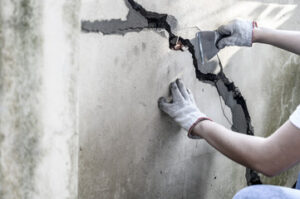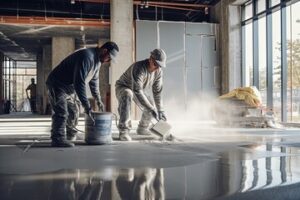Concrete repair is an important step in maintaining safe, functional, and aesthetically pleasing surfaces. It’s also an ongoing process to prevent damage and deterioration.

The ideal concrete repair method will depend on the type of deterioration. It’s important to take safety precautions, allocate sufficient time and budget, consider professional help, and practice proper maintenance to achieve the best results. To learn more, visit https://www.concreterepaireauclaire.com/.
Concrete cracks are inevitable and are the result of natural forces at work within concrete elements. As concrete dries, it undergoes an exothermic chemical reaction that causes water molecules to evaporate, creating voids and stresses which result in cracking. These cracks may also create a passageway for moisture and dissolved salts, which can cause damage and deterioration to the concrete element. Regular inspection and prompt repair of cracks can prevent the problems that they pose.
To repair cracks, the first step is to clean the area around the crack. This can be done with a pressure washer or detergent to remove any dirt or debris that has accumulated in the area. This will help to ensure that the crack filler has a good bond with the existing concrete surface.
After the crack has been cleaned, a backer rod should be stuffed into the crack to help hold the crack filler in place. The rod should be a size larger than the width of the crack. Then, the crack should be filled with a concrete patching material according to the manufacturer’s directions. It is important to follow the manufacturer’s instructions for application of the product, as different products require different preparation methods and drying times.
Once the crack has been filled, it should be lightly tamped with a hand tamper to settle the concrete patching and make sure there are no air pockets. The surface of the patch should then be sealed with a water-based acrylic, epoxy, or polyurethane coating to protect it from moisture and harsh weather conditions.
The final step is to use a concrete replacement method to replace the damaged concrete in the slab or wall. This can be accomplished with dry mix or wet mix repair. If the cracked concrete is a structural component of a structure, it may be necessary to use external prestressing strands or bars to add a compressive force to the cracks and improve the strength of the repaired concrete.
It is advisable to use the dry pack repair method for most crack repairs as it is easy and economical. It consists of one part cement and two and a half parts sand. This can be colour matched using different combinations of sand and cements.
Delaminations
Concrete is a tough and durable material, but it’s not immune to wear and tear. One common problem is delamination, where layers of concrete separate and weaken the structure. This can lead to structural issues, safety hazards, and expensive repairs.
Delaminations can be caused by a variety of factors, including improper construction techniques, poor curing practices, and poor-quality materials. They can also occur due to exposure to harsh weather conditions and aggressive chemicals. If a delamination is isolated, it may not affect the integrity of the concrete. But widespread delamination can be very dangerous and needs to be addressed immediately.
Unlike cracks, delaminations are not easy to spot in concrete slabs until the surface has set and hardened. They appear as hollow-sounding areas, exacerbated by traffic, and can range from a few square inches to several square feet in area. This makes them particularly difficult to repair, as they can’t be simply sanded down and resurfaced.
The best way to identify a delamination in a concrete slab is by tapping or sounding the surface. This can be done with a hammer or chain drag, and usually yields a different sound than solid concrete. If a drummy or clacking sound is heard, the concrete surface has delaminated and should be addressed immediately.
If the delamination is only on the surface, it can be repaired by patching. However, extensive delamination may require removal and reconstruction of the underlying concrete or reinforcement. This can be done with shotblasting, hydrodemolition, or grinding, depending on the extent of the damage. A high-strength resurfacing product should then be applied to the remaining sound concrete.
Water-related delaminations are usually more serious, as they can eat away at the underlying concrete. These can be prevented by ensuring adequate compaction during concrete placement and proper curing practices. They can also be reduced by not sealing the concrete until bleed water and air have escaped, and by using concrete resurfacing products with low water content. When these products are used, they should be tested for chemical resistance to ensure they’ll bond with the existing concrete.
Loose Joints
Those little expansion joints that run through the concrete slabs on sidewalks, driveways and commercial flooring need to be repaired when they start to chip. If they go untreated, the concrete slabs could crack and shift causing long-term damage.
The expansion joint is designed to allow the concrete pads to expand and contract with temperature changes without cracking the slabs. The joints are filled with a special material that is a bit more flexible than the concrete and acts as a shock absorber to help cushion the movement of the concrete slabs. The expansion joints need to be sealed with a waterproof sealant like QUIKRETE® Self-Leveling Polyurethane Sealant or QUIKRETE® Non-Sag Polyurethane Sealant.
If the expansion joint is left open, dirt and debris can collect in it which eventually erodes the mastic and causes the joint to become loose. Water seepage into the joint also makes it a breeding ground for weeds and other vegetation that can then cause further deterioration of the mastic and the joint filler.
The best way to repair a loose expansion joint is to dig out the old material and flush out the joints with a hose. Then clean the area with a wet-dry vacuum and apply a bonding adhesive. Allow the adhesive to dry for 10-15 minutes. Then insert a foam backer rod that is cut to length. This will act as a new shock absorber to protect the concrete from future stress and pressure.
Next use a caulking gun to apply the waterproof sealant. Start with a scratch coat that is a thin layer of the repair product mixed with water to a soupy consistency. Smear the scratch coat with a gloved hand to get it into all of the nooks and crannies of the joint.
Once the scratch coat has dried, apply a second thicker coat and smooth it out. When the second coat has dried, apply a third thin coat and then spray a fine layer of sand to blend in with the surrounding concrete and make it less obvious that you have used a repair material.
Faulty Foundations
The foundation of your home should be well built in order to keep it stable and prevent future problems. Foundation issues can develop if the soil is not properly compacted during construction or when there are changes in temperature that cause expansion and contraction of the concrete. When these shifts occur, the soil may be unable to support the weight of your structure and will start to move or crack.
Some foundation cracks are serious and can threaten your building’s structural integrity. These are called structural cracks and need to be repaired as soon as possible. Non-structural cracks are not as severe and can be caused by other factors such as shrinkage in concrete during curing or by the movement of earth underneath your foundation.
When your foundation is showing signs of movement it is important to contact a concrete repair specialist as soon as possible. It is also important to understand what is causing the movement so you can take steps to address it. Foundation problems can be caused by heaving soil, expansive clay, or insufficient excavation during construction. It is also common for older homes to experience a problem called foundation heave. This happens when the soil under the foundation gets too much exposure to water and expands causing the concrete slab to crack.
Another common issue is when the soil under the foundation is unable to support the structure and it starts to sink. This is often caused by soil erosion or settlement. This can lead to cracking in the foundation and in other areas of your home such as the basement floor, walls, and driveways.
Sometimes filling in horizontal cracks or other cosmetic repairs is not enough to stop foundation damage. In these cases, a professional contractor can perform lift and leveling services to solve the problem for good.
There are a number of solutions for foundation repair such as steel piers and helical piles. During these types of foundation repair, galvanized steel piers are driven into the ground beneath your home until they reach stable soil that is able to support the weight of your structure. Helical piles are similar to piers except they have threaded sections that allow them to be screwed into the ground.
